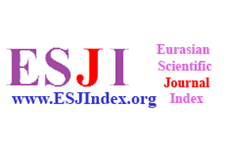Decision support procedures for decision making in a COVID condition
Boboyorov Sardor Uchqun o‘g‘li
Tashkent Medical Academy Termiz branch, Uzbekistan
Kuzomin Oleksandr
Department of Informatics, Kharkiv National University of Radio Electronics, Ukraine
Lyashenko Vyacheslav
Department of Media Systems and Technology, Kharkiv National University of Radio Electronics, Ukraine
Keywords: COVID-19, Risks, Pandemic, Methods, Models, Decision making, Support procedures
Abstract
Any negative situation requires an immediate response to its occurrence and further development. This is especially true in the presence of epidemiological factors in order to minimize various risks. Based on data on COVID-19, the work discusses general approaches to building a procedure to support relevant decision-making. The main generalizations and formalization in the form of mathematical relationships are presented. Attention is also paid to the key features of the solution procedures under consideration.
References
Gunasekaran, A., Ngai, E. W., & McGAUGHEY, R. E. (2008). Information technology and systems justification. In Evaluating information systems (pp. 1-34). Routledge.
Chehade, S., & et al.. (2019, October). Modelling Interactions in Rescue Operations. In 2019 IEEE International Conference on Systems, Man and Cybernetics (SMC) (pp. 4118-4123). IEEE.
Lunde, A., & Braut, G. S. (2019). The concept of overcommitment in rescue operations: some theoretical aspects based on empirical data. Air Medical Journal, 38(5), 343-349.
Ciotti, M., & et al.. (2020). The COVID-19 pandemic. Critical reviews in clinical laboratory sciences, 57(6), 365-388.
Mustafa, S. K., & et al.. (2020). Brief review of the mathematical models for analyzing and forecasting transmission of COVID-19. Journal of critical reviews, 7(19), 4206-4210.
Fauci, A. S., Lane, H. C., & Redfield, R. R. (2020). Covid-19–navigating the uncharted. New England Journal of Medicine, 382(13), 1268-1269.
Khoshnaw, S. H., & et al.. (2020). A quantitative and qualitative analysis of the COVID–19 pandemic model. Chaos, Solitons & Fractals, 138, 109932.
Adiga, A., & et al.. (2020). Mathematical models for covid-19 pandemic: a comparative analysis. Journal of the Indian Institute of Science, 100(4), 793-807.
Baranova, V., & et al.. (2019, October). Stochastic Frontier Analysis and Wavelet Ideology in the Study of Emergence of Threats in the Financial Markets. In 2019 IEEE International Scientific-Practical Conference Problems of Infocommunications, Science and Technology (PIC S&T) (pp. 341-344). IEEE.
Слюніна, Т. Л., Бережний, Є. Б., & Ляшенко, В. В. (2007). Розвиток вітчизняної мережі банківських установ: особливості та регіональні аспекти. Вісник ХНУ ім. В. Н. Каразіна. Економічна серія, 755. 84–88.
Ляшенко В. В. (2007). Интерпретация и анализ статистических данных, описывающих процессы экономической динамики. Бизнес Информ, 9(2), 108-113.
Vasiurenko, O., & et al.. (2020). Spatial-Temporal Analysis the Dynamics of Changes on the Foreign Exchange Market: an Empirical Estimates from Ukraine. Journal of Asian Multicultural Research for Economy and Management Study, 1(2), 1-6.
Nevliudov, I., & et al.. (2020). Development of a cyber design modeling declarative Language for cyber physical production systems. J. Math. Comput. Sci., 11(1), 520-542.
Ahmad, M. A., & et al.. (2020). Wavelet coherence as a tool for markers selection in the diagnosis of kidney disease. International Journal of Emerging Trends in Engineering Research, 8(2), 378-383.
Mustafa, S. K., & et al.. (2021). Some aspects of modeling in the study of COVID-19 data. International Journal of Pharmaceutical Research, 4124-4129.
Berger, L., & et al.. (2020). Uncertainty and decision-making during a crisis: How to make policy decisions in the COVID-19 context?. University of Chicago, Becker Friedman Institute for economics working paper, (2020-95).
Alsalem, M. A., & et al.. (2022). Multi-criteria decision-making for coronavirus disease 2019 applications: a theoretical analysis review. Artificial Intelligence Review, 55(6), 4979-5062.
Norheim, O. F., & et al.. (2021). Difficult trade-offs in response to COVID-19: the case for open and inclusive decision making. Nature Medicine, 27(1), 10-13.
Belhadi, A., & et al.. (2020). Infectious waste management strategy during COVID-19 pandemic in Africa: an integrated decision-making framework for selecting sustainable technologies. Environmental Management, 66, 1085-1104.
Ferrinho, P., & et al.. (2020). Principalism in public health decision making in the context of the COVID‐19 pandemic. The International Journal of Health Planning and Management, 35(5), 997-1000.
Gupta, R., & et al.. (2022). Decision-making framework for identifying regions vulnerable to transmission of COVID-19 pandemic. Computers & Industrial Engineering, 169, 108207.
DeFazio, J. R., & et al.. (2020). Development of pediatric surgical decision-making guidelines for COVID-19 in a New York City children's hospital. Journal of pediatric surgery, 55(8), 1427-1430.
Li, X., Liao, H., & Wen, Z. (2021). A consensus model to manage the non-cooperative behaviors of individuals in uncertain group decision making problems during the COVID-19 outbreak. Applied Soft Computing, 99, 106879.
Kuzemin, O., & Lyashenko, V. Microsituation Concept in GMES Decision Support Systems / A. Kuzemin, V. Lуashenko. Intelligent Data Processing in Global Monitoring for Environment and Security (pр. 217–238). – 2011 .– Р, 217-238.
Boboyorov Sardor Uchqun o‘g‘li, Oleksandr Kuzomin, & Lyashenko Vyacheslav. (2023). Situational-linguistic model of Covid-19 as a tool for ensuring the prevention and management of the pandemic. Journal of Universal Science Research, 1(9), 111–121.

















